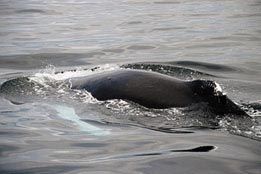
|
 |
 |
 News from Around the Americas | January 2005 News from Around the Americas | January 2005  
Trapped Dolphins Symbol of Hope
 Reuters Reuters

Singing, clapping and banging their boats with paddles, rescue workers tried unsuccessfully Tuesday to herd a humpback dolphin and her calf into nets so they could be rescued from a small lagoon where the Asian tsunamis dumped them nine days earlier.

 Khao Lak, Thailand - Singing, clapping and banging their boats with paddles, rescue workers tried unsuccessfully Tuesday to herd a humpback dolphin and her calf into nets so they could be rescued from a small lagoon where the Asian tsunamis dumped them nine days earlier. The dolphins, spotted Monday a kilometer (more than a half mile) from the beach by a man searching for his wife, have become a symbol of hope amid the death and destruction caused by the massive waves that crushed posh tourist resorts. Khao Lak, Thailand - Singing, clapping and banging their boats with paddles, rescue workers tried unsuccessfully Tuesday to herd a humpback dolphin and her calf into nets so they could be rescued from a small lagoon where the Asian tsunamis dumped them nine days earlier. The dolphins, spotted Monday a kilometer (more than a half mile) from the beach by a man searching for his wife, have become a symbol of hope amid the death and destruction caused by the massive waves that crushed posh tourist resorts.

"When we heard the good news about survivors, even though they're dolphins, it's great news," said Suwit Khunkitti, Thailand's minister of natural resources and environment. "I'm sure that everyone is happy to see at least some life after the tsunami." But the intense desire for a rescue attempt instead of the grim search for bodies led to dissension between a group of Greek divers from the Athens fire department and local fishermen. The divers, who realized their efforts to extricate the dolphins Monday were doomed because their nets were too small, were told to leave the lagoon after local officials arrived and said they would try a traditional technique, even though a dolphin expert warned that it could harm the mammals.

Men in boats, using larger nets, used a cacophony of noise to corner the animals, believed to be an Indo-Pacific humpback dolphin and her roughly 3-year-old offspring. But at mid-afternoon, the dolphins managed to slip out of the cordon, and the effort was called off for the day. It was unclear how much longer the dolphins could survive in the murky, stagnating mixture of salt water and fresh water that was likely dehydrating them. There were also concerns that the dolphins have no live fish to eat. The larger dolphin, about two meters (seven feet) long, appeared to have a back injury.

While the rescue attempt went on, volunteers spotted several human bodies in the nearby vegetation, and one in the lagoon. Even before Tuesday's effort began, American dolphin expert Jim Styers gave it only a 50-50 chance of success. "It's not going to be easy," said Styers, a Seattle man who is head consultant for the Myanmar Dolphin Project in Ranong, in northern Thailand, and has worked on a number of marine animal rescue efforts over the years, including the massive Exxon Valdez oil spill in Alaska. "This is extremely problematic in that we potentially have dead bodies also in the water, which causes concern with hygiene ... but also there are all kinds of trees on the bottom, so it's not like we can drag a net across because it can get hung up."

Sherry Grant, Asia director for Humane Society International, was surprised that the dolphins survived the tsunami, which apparently crashed over the tops of coconut trees in the area. "When you look at the commotion of cars and things like that, that they didn't get thrashed, hitting the trees, it's just amazing," she said. The Greek divers were unhappy to be forced out of the rescue effort, saying dolphins were considered to be almost human in their homeland. "It's very, very important for us to rescue these dolphins because they're the only things that survived the disaster ... the only signs of life," diver Estimios Papantonis said.

About 500-600 Indo-Pacific humpback dolphins are believed to inhabit the seas around Thailand, migrating between the Indian and Pacific oceans. | 
 | |
 |



